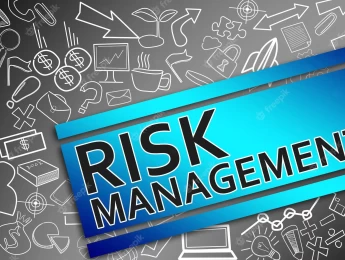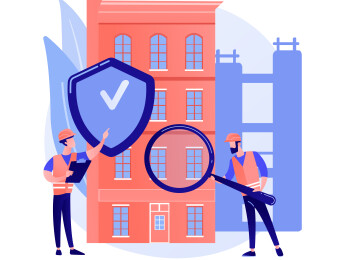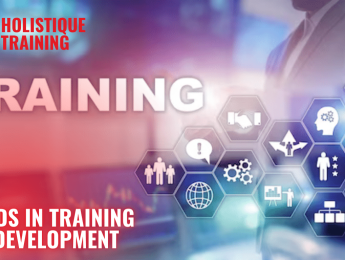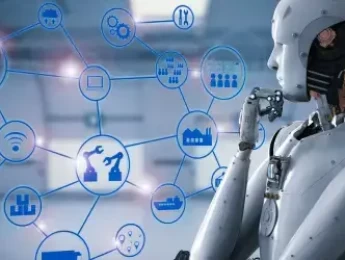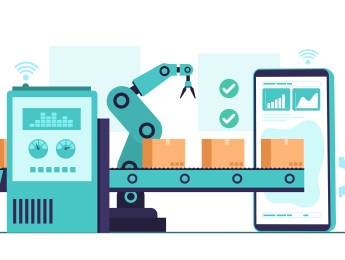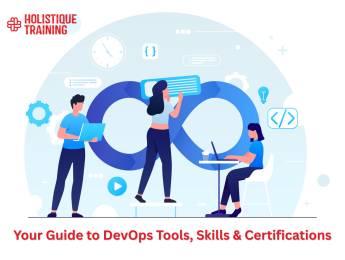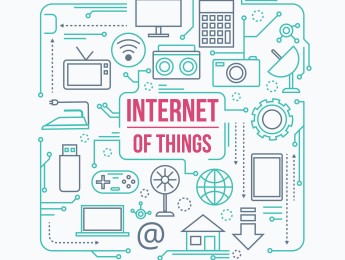- Table of Contents
- Introduction
- What Does Employee Relations Mean?
- The 4 Pillars of Strong Employee Relations
- 1. Communication
- 2. Fair and Consistent Policies
- 3. Conflict Resolution
- 4. Employee Development
- Why Is Employee Relations Important?
- Boosting Morale and Productivity
- Fostering Loyalty and Retention
- Enhancing Organisational Reputation
- Mitigating Workplace Disruptions
- Adapting to Change and Innovation
- Who Is Responsible for Employee Relations?
- a) Leadership Sets the Tone
- b) Human Resources as Facilitators
- c) Managers at the Frontline
- d) Individual Accountability
- c) Collective Commitment
- A Collaborative Symphony
- Common Employee Relations Issues
- 1. Disputes Over Compensation
- 2. Conflicts Among Team Members
- 3. Cultural Concerns
- 4. Job Security
- How to Develop Strong Employee Relations
- 1. Establish Trust as the Foundation
- 2. Encourage Open Communication
- 3. Promote Work-Life Balance
- 4. Recognise and Reward Contributions
- 5. Craft Opportunities for Employee Development
- 6. Leverage Technology for Better Employee Relations
- Writing a Transparent Employee Relations Policy
- 1. Clearly Defined Expectations
- 2. Procedures for Conflict Resolution
- 3. Communication Channels
- 4. Commitment to Fair Treatment
- 5. Regular Policy Updates
- Crafting an Employee-Friendly Document
- Training and Communication
- How Did Employee Relations Change Post-COVID-19?
- Conclusion
Introduction
Establishing a thriving workplace environment is a complex task that extends beyond the mere execution of business operations. It involves the delicate art of managing relationships among employees – a facet encapsulated by the term 'Employee Relations.' In this blog post, we will delve into the intricacies of this concept, exploring its meaning, the pillars supporting it, and its ever-evolving landscape in the post-COVID-19 era.
What Does Employee Relations Mean?
At its core, Employee Relations (ER) embodies the effort to foster and maintain a positive relationship between employers and employees. It encompasses a wide array of interactions, ranging from day-to-day communications to conflict resolution. More than a set of policies and procedures, ER is a dynamic and ongoing process that seeks to create a harmonious work environment where employees feel valued, heard, and engaged.
The 4 Pillars of Strong Employee Relations
A solid foundation is essential for the stability and prosperity of any structure, and the workplace is no exception. In the realm of Employee Relations (ER), this foundation is built upon four key pillars, each playing a pivotal role in shaping a positive and harmonious work environment.
1. Communication
At the heart of strong employee relations lieseffective communication. It is not merely the transmission of information but a dynamic exchange that fosters understanding, trust, and collaboration. Organizations must establish transparent channels that facilitate open dialogue at all levels. From leadership sharing the company's vision to frontline employees expressing their concerns, a culture of effective communication ensures that everyone feels heard and valued.
2. Fair and Consistent Policies
Fair and consistent policies serve as the framework that guides interactions within the workplace. These policies should be transparent, accessible, and applied uniformly to all employees. When rules and regulations are perceived as just and equitable, employees are more likely to trust the organisation, fostering a sense of security and predictability. This pillar ensures that everyone is held to the same standards, promoting a culture of fairness and accountability.
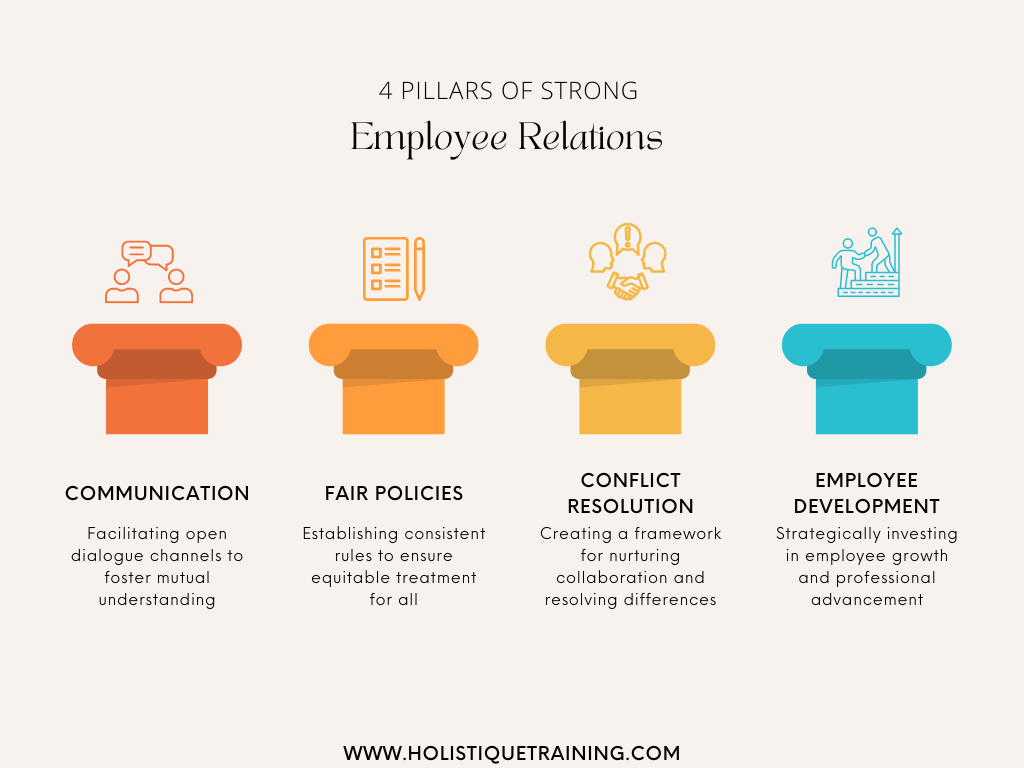
3. Conflict Resolution
Conflicts are an inevitable part of any human interaction, and the workplace is no exception. The effectiveness of resolving conflicts directly impacts the health of employee relations. A robust conflict resolution system involves active listening, impartial mediation, and a commitment to finding solutions that address the concerns of all parties involved. When conflicts are addressed promptly and fairly, it prevents them from escalating and contributes to a positive work environment where collaboration flourishes.
4. Employee Development
Employee development is not only about enhancing skills but also about fostering a sense of value and commitment. Organisations that invest in the professional growth of their employees signal a commitment to their well-being and success. This pillar involves providing opportunities for training, mentorship, and career advancement. By actively supporting the development of their workforce, organisations not only enhance productivity but also strengthen the bond between employees and the company.
In essence, these four pillars collectively support a workplace culture where trust, fairness, collaboration, and continuous improvement are not just ideals but integral components of day-to-day operations. As organisations focus on reinforcing these pillars, they create a sturdy foundation for strong employee relations, paving the way for sustained success and a positive work environment.
Why Is Employee Relations Important?
In the intricate tapestry of organisational success, the thread of positive Employee Relations (ER) weaves a fabric that is not just resilient but vibrant with productivity and engagement. Understanding the significance of ER goes beyond compliance; it is about fostering an environment where employees feel valued, motivated, and integral to the achievement of collective goals.
Boosting Morale and Productivity
Positive employee relations are a powerful elixir for morale and productivity. When employees feel that their contributions are recognised and their concerns are heard, they are more likely to be engaged and committed to their work. A motivated workforce not only performs better but also becomes an invaluable asset in driving innovation and achieving organisational objectives.
Fostering Loyalty and Retention
A workplace that prioritises employee relations is one that encourages loyalty. Employees are more likely to stay with an organisation where they feel a sense of belonging and where their professional growth is nurtured. Reduced turnover not only saves on recruitment costs but also ensures the retention of institutional knowledge and expertise, contributing to long-term stability.
Enhancing Organisational Reputation
Employee relations play a pivotal role in shaping an organisation's reputation. A workplace known for fair treatment, open communication, and positive relations is attractive to both current and prospective employees. Moreover, such organisations are likely to be viewed favourably by clients, partners, and the wider community. A positive company reputation becomes a valuable asset that extends beyond the confines of the workplace.
Mitigating Workplace Disruptions
Proactive management of employee relations helps prevent and mitigate workplace disruptions. By addressing concerns and conflicts in their early stages, organisations can avoid escalations that could impact the overall work environment. A well-structured ER framework acts as a preventive measure, ensuring that potential issues are identified and resolved before they adversely affect employee morale and organisational performance.
Adapting to Change and Innovation
In an era of constant change, organisations with strong employee relations are better positioned to adapt and innovate. A culture of open communication and collaboration encourages the exchange of ideas, making it easier for organisations to embrace change and respond to evolving market dynamics. Employees who feel supported are more likely to contribute creatively and be proactive in the face of challenges.
Employee relations are not merely a box to check in the HR manual; they are the linchpin that holds together the various facets of organisational success. From individual job satisfaction to overall productivity and reputation, positive employee relations create a ripple effect that extends far beyond the confines of the workplace. Organisations that prioritise ER are not only investing in their employees but also laying the groundwork for sustained success in a dynamic and competitive business landscape.
Who Is Responsible for Employee Relations?
The responsibility for cultivating positive Employee Relations (ER) extends far beyond the confines of the human resources department. While HR plays a central role, the commitment to fostering a harmonious workplace is a shared endeavour that involves every individual within an organisation.
a) Leadership Sets the Tone
At the forefront of responsibility lies the leadership team. Executives, managers, and team leaders play a pivotal role in setting the tone for a positive work culture. Their actions, decisions, and communication styles directly influence the atmosphere of the workplace. When leadership demonstrates a genuine commitment to values such as fairness, open communication, and employee well-being, it sends a powerful message that resonates throughout the organisation.
b) Human Resources as Facilitators
While leaders set the tone, the HR department serves as a crucial facilitator of ER initiatives. Statistics show that HR managers allocate a minimum of 24% of their time addressing employee relations issues. They are responsible for designing and implementing policies, procedures, and programmes that support positive employee relations. This includes creating communication channels, conflict resolution frameworks, and strategies for employee development. HR also plays a key role in addressing individual concerns and ensuring that the organisation remains compliant with employment laws and regulations.
c) Managers at the Frontline
Front-line managers are the day-to-day stewards of employee relations. They are the direct link between leadership and individual team members, making their role pivotal in translating organisational values into actionable practices. Managers are responsible for fostering a positive team culture, addressing concerns, and ensuring that employees feel heard and valued. By providing guidance, support, and clear communication, managers contribute significantly to the overall health of employee relations.
d) Individual Accountability
Every employee within an organisation carries a degree of responsibility for maintaining a positive ER. Respecting colleagues, adhering to company policies, and actively participating in communication channels are integral aspects of individual accountability. When each team member takes ownership of their role in fostering a positive work environment, it contributes to a collective culture of collaboration, respect, and shared success.
c) Collective Commitment
In essence, the responsibility for employee relations is a shared commitment that permeates every level of an organisation. It's not confined to a particular department or role but is a collective ethos that guides the interactions, decisions, and behaviours of everyone within the workplace. Recognising that employee relations is a team effort ensures that the organisation operates as a cohesive unit, with each member contributing to the creation of a positive and thriving work environment.
A Collaborative Symphony
In the symphony of employee relations, each player has a distinct role, yet the harmony is achieved through collaborative effort. From leadership setting the melody to HR crafting the supporting notes, and individual employees contributing to the rhythm, the responsibility for fostering positive employee relations is a collective endeavour. When each member of the organisation actively participates in this shared responsibility, the result is a harmonious workplace culture that resonates with unity, trust, and shared success.
Common Employee Relations Issues
1. Disputes Over Compensation
Compensation is a fundamental aspect of the employer-employee relationship. Disputes can arise when employees perceive their compensation as unfair or inconsistent. To address this, organisations must ensure transparency in their compensation structures, communicate clearly about pay policies, and regularly benchmark salaries to market standards. Implementing performance-based incentives and providing avenues for employees to discuss compensation concerns can foster a sense of equity.
2. Conflicts Among Team Members
Interpersonal conflicts within teams can impede collaboration and productivity. Addressing conflicts promptly involves creating an open communication channel where employees feel comfortable expressing their concerns. Team-building activities, conflict resolution training, and clearly defined roles and responsibilities can help prevent conflicts. When conflicts do arise, a structured mediation process facilitated by HR or management can provide a fair and impartial resolution.
3. Cultural Concerns
Differences in workplace culture can lead to misunderstandings and discomfort among employees. Organisations must foster an inclusive culture that respects diversity. Training programs on cultural sensitivity, establishing clear expectations for behaviour, and promoting open discussions about different perspectives contribute to a harmonious workplace. Leadership plays a crucial role in setting the tone for an inclusive and culturally diverse environment.
4. Job Security
Concerns about job security can create anxiety and hinder employee engagement. In fact, studies indicate a 37% decrease in engagement for employees experiencing job stability concerns. Transparent communication about the organisation's financial health, performance expectations, and future plans is essential. Providing opportunities for skill development and career growth reassures employees about their professional trajectory within the company. During challenging times, being honest about potential difficulties and outlining plans for addressing them can contribute to a sense of trust and stability.
In essence, recognising and proactively addressing common ER issues requires a multi-faceted approach that combines clear communication, training, fair policies, and a commitment to fostering a positive workplace culture. By navigating these challenges adeptly, organisations can build a resilient workforce and promote a harmonious work environment conducive to sustained success.
How to Develop Strong Employee Relations
Developing and maintaining strong employee relations requires a multi-faceted approach. Here are some strategies to foster a positive workplace culture:
1. Establish Trust as the Foundation
Trust is the bedrock of strong employee relations. Organisations must cultivate an environment where employees feel confident that their contributions are valued and their concerns will be heard. Leadership transparency, consistency in decision-making, and delivering on commitments are essential elements in building and maintaining trust. Establishing trust requires time and consistency but pays dividends in employee engagement and commitment.
2. Encourage Open Communication
Communication is a two-way street. Organisations should not only disseminate information effectively but also encourage employees to voice their thoughts and concerns. Regular team meetings, town hall sessions, and feedback channels create opportunities for open communication. Actively listening to employee feedback, acknowledging concerns, and addressing them promptly demonstrate a commitment to fostering a communicative and inclusive culture.
3. Promote Work-Life Balance
Recognising the importance of work-life balance is crucial in preventing burnout and promoting overall well-being. Flexible work arrangements, remote work options, and policies that support a healthy work-life balance contribute to employee satisfaction. Organisations that prioritise the well-being of their employees foster a positive workplace culture that values individuals beyond their roles.
4. Recognise and Reward Contributions
Acknowledging and appreciating employee contributions is a powerful motivator. In fact, according to SHRM, as cited by Symmetrical, a staggering 84% of HR professionals affirm that employee recognition heightens engagement, while 82% assert its positive impact on happiness and staff availability. Establishing a formal recognition program, expressing gratitude for a job well done, and providing opportunities for career advancement are ways to recognise and reward employees. When employees feel valued, they are more likely to be engaged and committed to the organisation's success.
5. Craft Opportunities for Employee Development
Investing in the professional growth and development of employees benefits both individuals and the organisation. Providing training programs, mentorship opportunities, and clear paths for career advancement demonstrate a commitment to employees' long-term success. Employee development not only enhances skills but also strengthens the bond between employees and the organisation.
6. Leverage Technology for Better Employee Relations
In the digital age, technology plays a pivotal role in enhancing employee relations. HR software, communication platforms, and employee engagement tools streamline processes, facilitate communication, and provide valuable insights. Leveraging technology effectively allows organisations to stay agile and responsive to the evolving needs of their workforce, fostering stronger connections and collaboration.
Developing strong employee relations is an ongoing commitment that requires dedication from every level of an organisation. By prioritising trust, open communication, work-life balance, recognition, and employee development, organisations cultivate a culture where employees feel valued and connected. As workplaces evolve, those that invest in building and sustaining positive employee relations will reap the rewards of a motivated, engaged, and resilient workforce.
Table 1: Key metrics to measure the effectiveness of employee relations management
Metrics | Description |
Employee Satisfaction Index | Gauges overall contentment and engagement levels. |
Conflict Resolution Timeliness | Measures efficiency in resolving workplace conflicts. |
Retention Rate | Reflects employee loyalty and organisational appeal. |
Communication Effectiveness | Assesses clarity and impact of internal communications. |
Professional Development Index | Evaluates success in fostering employee skill growth. |
Writing a Transparent Employee Relations Policy
A well-crafted and transparent Employee Relations (ER) policy serves as the compass guiding interactions within an organisation. It not only outlines the expectations and standards for employee conduct but also communicates the organisation's commitment to fairness, open communication, and a positive work environment. Let's delve into the key elements that contribute to an effective and transparent ER policy.
1. Clearly Defined Expectations
The foundation of any ER policy lies in clearly articulated expectations for employee behaviour and conduct. This includes standards for professionalism, ethics, and compliance with company policies. By setting unambiguous expectations, employees are empowered with a clear understanding of the organisation's values and behavioural norms.
2. Procedures for Conflict Resolution
A robust ER policy should include detailed procedures for addressing conflicts at various levels. This involves establishing clear channels for employees to raise concerns, mechanisms for resolving disputes, and a commitment to fair and impartial investigations. By providing a roadmap for conflict resolution, the policy demonstrates the organisation's dedication to fostering a healthy and harmonious workplace.
3. Communication Channels
Transparency is closely tied to communication. The policy should outline the various channels through which employees can communicate with management, HR, and each other. This includes avenues for reporting issues, providing feedback, and seeking assistance. Well-defined communication channels promote openness and accessibility, crucial elements in building trust within the organisation.
4. Commitment to Fair Treatment
Emphasising a commitment to fair treatment is integral to an effective ER policy. This involves ensuring that policies and disciplinary actions are applied consistently and equitably across all levels of the organisation. By explicitly stating the organisation's dedication to fair treatment, the policy becomes a tool for instilling confidence and trust among employees.
5. Regular Policy Updates
The workplace is dynamic, and policies must evolve to meet the changing needs of the organisation and its workforce. A transparent ER policy should include provisions for regular updates and reviews. This not only ensures that the policy remains aligned with the organisation's values but also communicates a commitment to continuous improvement and responsiveness to employee feedback.
Crafting an Employee-Friendly Document
An effective ER policy should not be a dense legal document but rather a clear and accessible guide for employees. The language should be straightforward, avoiding unnecessary jargon, and the document should be easily navigable. Including real-world examples and scenarios can help employees better understand the practical application of the policy.
Training and Communication
Simply having a policy is not enough; employees need to be aware of its existence and understand its contents. Implementing training sessions and communication campaigns to educate employees about the ER policy ensures that everyone is on the same page. This proactive approach fosters a culture of compliance and encourages employees to seek resolution within the established framework.
A transparent ER policy is more than a set of rules; it is a commitment to fostering a workplace culture built on trust, fairness, and open communication. By incorporating clear expectations, robust conflict resolution procedures, accessible communication channels, a commitment to fair treatment, regular updates, and employee-friendly language, organisations lay the groundwork for a positive and transparent employee relations framework. As a living document, the ER policy becomes a dynamic tool that reflects the organisation's values and dedication to creating a workplace where employees can thrive.
How Did Employee Relations Change Post-COVID-19?
The COVID-19 pandemic brought about a seismic shift in the way people work and interact. Remote work became the norm, posing new challenges and opportunities for employee relations. Organisations had to adapt swiftly, implementing virtual communication strategies, addressing concerns related to work-from-home arrangements, and prioritising employee well-being in the face of unprecedented uncertainty.
The shift to remote work also underscored the importance of flexibility and empathy in employee relations. Organisations that demonstrated understanding and provided the necessary support thrived in maintaining positive relationships with their employees. The post-COVID-19 era thus emphasised the need for adaptability and a renewed focus on employee mental health and work-life balance.
Conclusion
In conclusion, the fabric of any successful organisation is woven from the threads of strong employee relations. By prioritising communication, fairness, conflict resolution, and employee development, organisations can create a workplace where individuals feel valued and motivated. With a clear and transparent employee relations policy, the right use of technology, and a commitment to adapting to changing circumstances, organisations can navigate the evolving landscape of employee relations, fostering a culture of collaboration, innovation, and sustained success.
Intrigued by the transformative power of strong employee relations? Elevate your organisation's potential with our comprehensive course, ‘The Importance of Developing Employee Relations.’ Uncover the intricacies of fostering a positive workplace culture through effective communication, fair policies, and conflict resolution. Dive into strategies for employee development, learn to craft transparent ER policies, and explore the strategic use of technology in enhancing relations. Equip your team with the skills to navigate the dynamic terrain of employee relations, fostering a culture of collaboration, innovation, and enduring success. Invest in your organisation's future – enrol in our course today and unlock the key to a thriving workplace.







